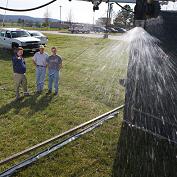Alum curbs phosphorus runoff, reduces ammonia levels

Results from a long-term study by the Agricultural Research Service support the use of aluminium sulphate to reduce phosphorous runoff from pastures, and to reduce ammonia emissions in poultry houses.
Alum treatment has been patented and available commercially since 1997, but there have been no long-term studies into its effects – until now.
Philip Moore, an ARS scientist, and Dwayne Edwards, an agricultural engineer at the University of Kentucky-Lexington, began two 20-year studies in the mid-1990s to evaluate the effects of alum.
The results of the first 10 years of the study are now in, and the news is better than expected: Applying alum-treated litter reduced phosphorus runoff by 75 percent at the watershed scale and as much as 87 percent from the small plots.
Researchers also found that alum reduced ammonia levels in poultry houses by about 70 percent. This is important because ammonia reduces birds’ weight and makes them more susceptible to viruses. And alum is known to reduce pathogens in litter and on birds, further contributing to a healthier environment for both workers and birds.
Field trials conducted at commercial broiler farms in conjunction with the US Environmental Protection Agency showed that alum lowered litter pH during the first 3 to 4 weeks of chick growth. The lower pH resulted in less ammonia evaporating, or volatilising, from the litter. Laboratory studies confirmed that alum is one of the most effective compounds for reducing ammonia volatilisation.
“Less ammonia means healthier, heavier birds,†Moore says. “It also leads to lower energy bills because less ventilation is needed.â€
Join 31,000+ subscribers
Subscribe to our newsletter to stay updated about all the need-to-know content in the poultry sector, three times a week. Beheer
Beheer








 WP Admin
WP Admin  Bewerk bericht
Bewerk bericht